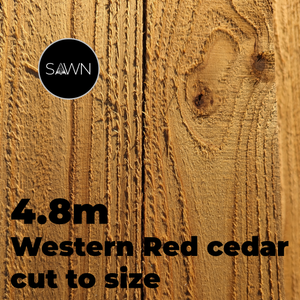
1.8M Western Red Cedar cut to size
1.8m Western Red Cedar Cut to Size – Reliable, Beautiful Timber for Your Outdoor Projects
Our 1.8m Western Red Cedar Cut to Size offers the perfect solution for those looking for durable, easy-to-handle timber for outdoor applications. Known for its natural beauty, resilience, and lightweight properties, Western Red Cedar is ideal for fencing, cladding, and garden structures. With our custom cut-to-size service, you get timber tailored to your exact needs, ready for easy installation.
Why Choose 1.8m Western Red Cedar Cut to Size?
1. Superior Durability
Western Red Cedar is known for its outstanding resistance to moisture, decay, and pests. This makes it one of the most reliable choices for outdoor projects that need to endure the elements year after year. Whether you're building a fence, garden shed, or decking, this timber will maintain its strength and beauty even in challenging weather conditions.
2. Warm, Natural Colour
The rich hues of Western Red Cedar, ranging from light honey to deep reddish-brown, bring a warm and inviting look to any outdoor project. While UK-grown cedar doesn’t have the same vibrant reds as its Canadian counterpart, it offers a more subtle, rustic charm that weathers into a lovely silvery-grey patina over time, adding to its natural beauty.
3. Tailored to Your Needs – Custom Cut to Size
Our cut-to-size service ensures your 1.8m Western Red Cedar arrives customized to your exact specifications. This means less time spent on cutting and measuring, and more time spent on your project. Whether you're working on a small-scale garden feature or need specific lengths for fencing or cladding, we provide the perfect timber fit for your needs, with no waste.
4. Lightweight and Easy to Work With
Despite its strength, Western Red Cedar is lightweight, making it easy to handle and cut, especially for DIY projects or when working with larger installations. Its manageable weight simplifies the cutting and fitting process, which is ideal for anyone looking to streamline their outdoor construction.
5. Environmentally Sustainable
Our Western Red Cedar is sourced from sustainable forests, ensuring that each purchase helps support eco-friendly practices. With this timber, you’re choosing not only a high-quality material but one that’s been harvested with respect for the environment, making it a great choice for the conscious consumer.
Product Details
-
Material: Premium Western Red Cedar
-
Length: 1.8m (custom cut to your requirements)
-
Finish: Sawn (retains natural texture, not planed smooth)
-
Colour: Light honey to deep reddish-brown, weathering to a silvery-grey
-
Durability: Naturally resistant to moisture, decay, and pests
-
Applications: Perfect for fencing, cladding, garden structures, and more
-
Sustainability: Sourced from certified sustainable forests
Why Buy From Sawn Sawmill?
-
High-Quality Timber: Our 1.8m Western Red Cedar is carefully selected to ensure you get the best possible material for your outdoor projects.
-
Custom Cutting: We provide a cut-to-size service, so your timber arrives ready to use, saving you time and reducing waste.
-
Efficient Delivery: We ensure quick, reliable delivery so you can get started on your project without delay.
-
Expert Advice: Our team is always on hand to help you select the right timber and offer advice on installation and care.
Order Your 1.8m Western Red Cedar Cut to Size Today
For those looking for a reliable, beautiful, and easy-to-handle timber solution for outdoor projects, our 1.8m Western Red Cedar Cut to Size is the perfect choice. Whether you’re building a fence, garden structure, or cladding, this timber offers long-lasting beauty and performance. Order today, or contact us for more information and expert guidance!








